Eng Kuta is targeting 80,000 kilograms of kasse in 2024/2025
About nine kilometers along Kikyusa road off Kampala-Gulu Highway is Kikerege Trading Centre and a few meters behind it is JBK Farm.
The 30-acre farm belongs to Jossy Balissa Kuta, a Biomedical Engineer, who is so knowledgeable and passionate about coffee farming. Out of the 30 acres, Kuta dedicated 27 of them to coffee farming. The three acres accommodate a house for workers, store, goats pen (he rears about 30 goats under zero grazing), a cemented drying yard (100ft*50ft) and the rest is used for maize growing.
A guided tour of the farm will make one conclude that this is one of the best maintained coffee farms in Uganda. One can also easily conclude that the farm sits on best soils for coffee, but the opposite is true; a larger part of the land is murram while the lower part near a swamp is sandy. So, what magic has he done to ensure the coffee thrives under this soil type?
The journey
When Business Focus visited JBK Farm on May 12, 2023, we found Kuta inspecting his shamba. He had just arrived from Kampala for his routine farm visit.
The 45-year-old took us on a guided tour of the farm as he narrated his journey into coffee farming.
He says he started planting coffee in a phased manner nine years ago. This means his coffee is at different stages of growth.
On what motivated him to join coffee farming, Kuta says he was inspired by his father who had coffee milling machines and the traders who became millionaires trading coffee.
“My father would take us to work at milling machines during the holidays. I used to see how someone came into the market as a trader with half a million and at the end of two years he’s a multimillionaire,” he says, adding that he decided to go for coffee farming because most of the coffee traders end up in debts and losing their properties due to borrowing at higher interest rates and poor business management.
“… In case of market failure, a trader can lose all his capital and properties. When a season is poor for the farmer, he can wait for the next one,” he says, adding coffee is a generational crop.
He first planted 6,000 coffee plantlets in 2014, but 1,500 dried up.
He learnt the lessons and carried on. He says it’s better to plant plantlets in bigger pots and with six leaves up wards.
He says he mainly depended on income from his job to start and expand the coffee farming business.
He has mainly planted old clonal cuttings.
In total, he has 30,000 coffee trees and of these, only 6,500 are CWD-r (Coffee Wilt Disease resistant aka KR) varieties.
He says he prefers old cuttings because “they have bigger berries compared to KR varieties. KR varieties are high yielding but have smaller beans. As a farmer, I’m looking at the weight and grades.”
Kuta says he first used 12ft*12ft spacing. However, in 2019, Kuta visited Joseph Nkandu, a farmer famed for introducing the 3m*1m spacing aka Brazilian style. After the visit, he adjusted his spacing.
“We decided to best utilize the spaces by planting more coffee trees to make it 6ft*12ft,” he says, adding at some point the coffee interlocks, the reason he leaves only two branches on trees.
He says he likes Line ‘B’ because it regularly flowers and therefore gives a farmer coffee even when it’s off season.
“B has big berries. Because of its slow growth, it flowers late but ensures you are harvesting when the season has ended. When others are out of business, you’re in business,” Kuta says.
In 2019, he tried out a new spacing method after visiting Nkandu. He planted 6,500 plantlets (CWD-r varieties) using 10ft*5ft spacing and the coffee is generally doing well four years down the road.
“We expect maximum production from this particular block next year. It already gave us a good harvest last season,” he says.
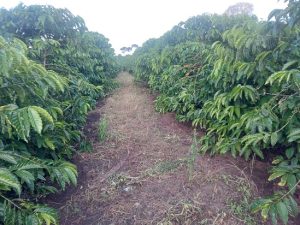
Although he has 27 acres of coffee, Kuta says his coffee is worth 70 acres given the spacing he’s using.
Asked if he isn’t scared of the devastating coffee wilt disease that can attack old clones after heavy investment, Kuta said coffee just like a human being, requires good feeding to prevent diseases.
“I look after my coffee very well. I get coffee wilt but in a year, I can’t exceed five trees getting affected,” he says.
Improving fertility
His coffee is generally green despite the soil being sandy and a few inches from murram. He says he applies manure, inorganic fertilizers and irrigates during the dry spell. Since his top soil is a few inches away from murram, he uses maize stalks to mulch coffee and “create more soil.”
He also applies more manure on a block/section with more murram. On irrigation, he says: “For the entire farm, we use 60,000 litres per day when we irrigate during the dry spell.”
He uses a petrol pump to pump water from a dam that was excavated a few meters away from the farm.
“It is expensive but worth it,” he says, adding that it wouldn’t make sense to apply fertilizers to boost coffee growth and flowering only to have the coffee affected by the short dry spell.
“The water demand reduces every year that passes since roots are growing deeper,” he says.
On fertilizers, he says: “.. We first gave each coffee 200g of fertilizers at the start of the rainy season. We have just finished applying more 100g on each tree. This means this rainy season each coffee tree has received 300g of fertilizers.”
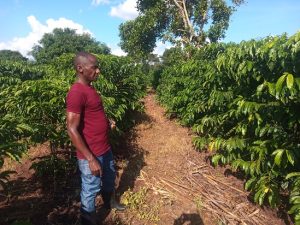
Kuta adds that the same process will be repeated in the second rainy season.
He says he interchanges fertilizers based on expert advice and his research.
“Here we feed the trees differently. If a particular block like this one (a few yellowish trees on a sandy area) is looking poor and malnourished, it will get special feeding,” he says, adding that his focus is to ensure he gets many coffee twigs and nodes.
“We are going to add seven spades of manure on each tree this year to stabilize the soil around this section. You can have coffee where there’s sand,” he adds.
He says from his experience, goats manure is the best for coffee. He notes that fertilizer application helps him get good harvest both during the main and off season.
At the time of our visit, we found workers pruning after unwanted suckers sprouted strongly due to recent heavy rains and application of fertilizers. He says pruning helps them control the devastating Black Coffee Twig Borer (BCTB).
Kuta also reveals that stumped trees are more productive/high yielding compared to non-stumped ones because they have deeper and stronger roots.
Controlling Weeds
Kuta mainly uses spot weeding and herbicides to control weeds.
“We often slash the weeds before applying herbicides. Timely application of herbicides is important. Don’t wait for them to flower and bear seeds,” he says
Workers
Eng. Kuta employs five permanent staff including the manager, assistant manager, cook, security guard and someone incharge of goats. These are accommodated at the farm. Other temporary workers come in when there’s demand especially during harvesting, spraying, pruning and application of manure and fertilizers.
To ease the work of the manager, Kuta says he’ll soon deploy a drone for easy monitoring and detection of diseases.
“I pay my workers on time,” he says, adding that permanent workers are paid extra money per work done besides the salary they get for their well defined roles.
Harvest
Last year, Kuta harvested four lorries of kiboko (dry cherries). Each lorry is worth 120 bags, implying that he harvested about 480 bags of kiboko.
He says he sold the coffee as kiboko because many buyers of Fair Average Quality (FAQ/Kasse) are exploitative in nature especially when one’s coffee is at the milling factory.
“If kasse is at Shs7,000 and my out turn is 50%, I will sell kiboko if someone gives me Shs3400. I won’t make a loss,” he says, adding that it’s a wrong perception for farmers to think that kasse guarantees a farmer more money.
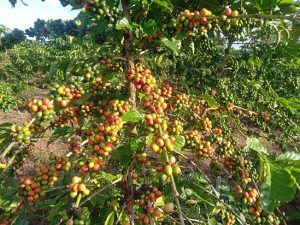
He says some farmers forget the expenses of having kasse including loading and unloading fees, transport and milling charges.
“You have to monitor your coffee 24/7 until it’s milled,” he says, adding that he will do grading once he starts getting 12 lorries of kiboko per year, a feat he hopes to achieve in 2024/2025.
Given the fact that a lorry can carry about 120 bags of kiboko, 12 lorries would carry a combined 1,440 bags of kiboko.
He has already started harvesting coffee for the off season but due to his extraordinary care, you may mistake the yield for the main season.
Fertiliser boosts harvest
He says he first applied a fertilizer blended for coffee in 2017 and the results were impressive.
“I harvested 265 bags in 2018 from 5,500 trees. I imagined what the harvest would be with 30,000 coffee trees at maximum production! That’s when I decided to seriously reinvest in this plantation through application of the right fertilizers,” he says.
He says casual workers are trained to pick only red cherries.
They are paid per kilogram harvested. He adds that he gives workers breakfast, lunch and dinner.
“At the peak of harvest, I give Shs100 per kilogram harvested because there are other input costs as mentioned earlier,” he says.
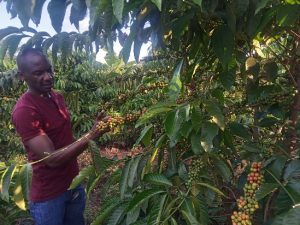
He dries up his on a cemented floor and tarpaulins. However, he’ll need about 10 drying yards of 100ft*50ft once his coffee reaches optimum production. “The current yard can only accommodate 80 bags of wet coffee,” he says, adding that he’s also exploring using solar drying.
Expenditure
Asked about the expenditure on the farm, Kuta says his expenditure varies according to situations. For example, during the dry spell the weeds are subdued and therefore he doesn’t spend on herbicides. He however spends more on irrigation and labour.
“During the dry season, I spend an average of Shs3.5m on the farm per month,” he says, adding that the expenditure increases during the rainy season due to application of fertilizers and manure.
“We also spend much money to control weeds during the rainy season. To spray the entire farm with herbicides, we need three boxes. A box is now averaging Shs360,000,” he says.
Kuta says on average, he spends over Shs100m on the farm per year but it’s worth it.
“Mine is a long term investment. As you’re beginning to get money from the coffee planted in 2014, you are still expanding. You use this money and add more from your pocket to plant more coffee,” he says, adding that his break-even point is expected next year because there’s no more planting.
“I did it deliberately because I knew I would reap in future. I don’t intend to plant more coffee. I will consolidate and maintain this plantation,” he says, adding: “I will start paying myself next year.”
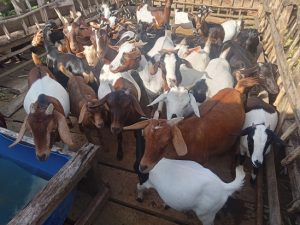
He says he keeps records of his farm and from his experience, a farmer will have spent an average of Shs20,000 on a coffee tree up to four years. He says although clonal coffee will start flowering in two years, a good harvest should be expected after four years.
Challenges
Besides the dry spells and the pests and diseases, Kuta says it’s challenging to maintain a farm like his especially in formative years before harvest starts. He says planting in phases helped him avoid cash flow issues.
“I have been using income from my job to maintain and expand this farm. I have also been getting loans. I normally repay after harvest,” he says.
He adds that there are products on the market that don’t meet farmers’ expectations.
“We normally believe in the people behind these products but some people are not knowledgeable about the products they are selling,” he says, adding: “Some products are genuine but don’t serve the purpose as per the writing. A farmer needs to experiment them on a small scale.”
He adds that the fluctuating prices of inputs affects planning.
He cites prices of herbicides and fertilizers that have shot up in recent years.
“Coffee farmers are price takers. This means we are not in full control of what we produce,” he says, adding that once coffee prices rise, theft cases also increase in the area. He however says they can be contained by putting in place various security measures. Besides the security guard, he also has dogs.
He adds that mobilizing labour within his area is also a big challenge as many young people don’t want to work.
“Next year, we shall need 65 casual workers to harvest coffee, but it will be challenging getting them from around,” he says.
Future plans
Kuta says at optimum production, he expects to be harvesting an average of 2.5kg of kasse per tree per year.
“I will be expecting between 75,000kgs and 80,000kgs of FAQ per year,” he says, adding: “Once we reach that stage, I will start grading and if our coffee performs well, we shall look into the export business because you can export a container,” he says.
On retirement, he says he would have retired into coffee farming but his job keeps his brain at work. He adds that not being on the farm permanently helps him network and get buyers for his coffee easily.
“I don’t want to be thinking about coffee all the time. I want to continue exercising my brain; I have electronics that have failed and need repairs… I don’t want to limit the exercise of my brain by waking up thinking about coffee only,” he says, revealing what keeps him on his current job.
For tips, opinions and advertising, Tel: 0775170346/0703828741/staddewo@gmail.com. Follow us on Twitter: @TaddewoS @BusinessFocusug


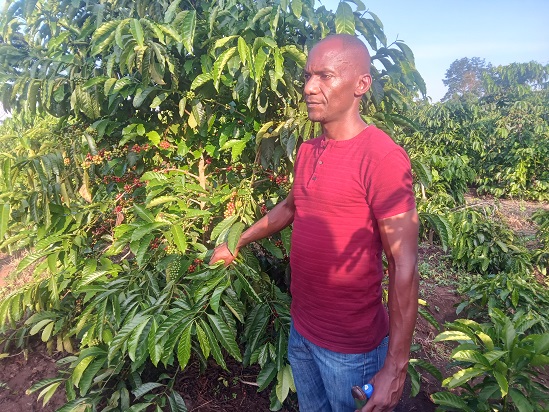

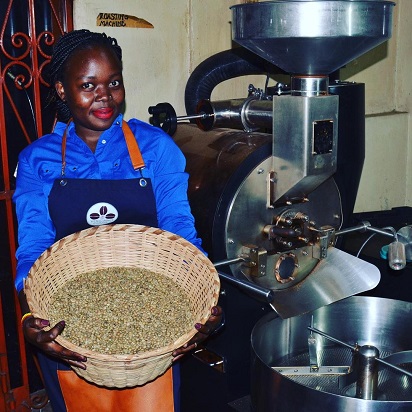


I need to attend the training on 26/8/2023